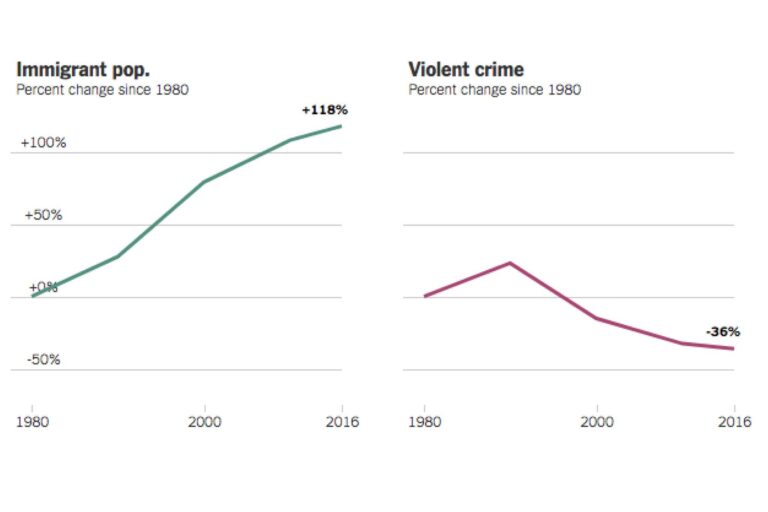In recent years, public discourse surrounding immigration has often been clouded by misconceptions linking immigrants to criminal activity. However, a comprehensive analysis by the American Immigration Council challenges these prevailing myths, offering data-driven insights that refute the stereotype of immigrants as a threat to public safety. This article delves into the Council’s findings, presenting a clear-eyed view of the relationship between immigration and crime in the United States.
Immigration and Crime Rates Analyzing Data Beyond Stereotypes
Extensive research consistently shows that immigrants are less likely to commit crimes than native-born citizens, contradicting widespread public misconceptions. Multiple studies analyzing FBI and local law enforcement data reveal that immigrant communities often experience lower crime rates across various categories, including violent offenses and property crimes. Factors such as strong community ties, economic motivation, and cultural values contribute to this trend, underscoring the need to move beyond simplistic narratives.
Key findings from recent analyses include:
- Immigrant populations have a lower incarceration rate compared to native-born Americans.
- Crime rates in neighborhoods with high immigrant density tend to be significantly lower.
- Efforts to equate immigration with increased criminal activity ignore complex social and economic dynamics.
| Community Type | Violent Crime Rate (per 100,000) | Property Crime Rate (per 100,000) |
|---|---|---|
| High Immigrant Population | 150 | 400 |
| Low Immigrant Population | 230 | 550 |
The Impact of Immigrant Communities on Public Safety and Local Economies
Immigrant communities play a pivotal role in strengthening public safety in cities across the United States. Contrary to widespread misconceptions, extensive research consistently shows that immigrants—both documented and undocumented—tend to commit fewer crimes than native-born residents. This trend remains true across various crime categories, from violent offenses to property crimes. Data from multiple urban centers reveals that neighborhoods with higher immigrant populations often experience lower crime rates. Law enforcement officials and criminologists alike emphasize that social cohesion, community engagement, and the economic contributions of immigrants substantially reduce crime risks.
Beyond enhancing safety, immigrant communities are a dynamic economic engine for local economies. Their participation in the workforce contributes to job creation, entrepreneurship, and increased consumer demand, which benefits businesses and municipalities. The following table showcases a snapshot of economic indicators in cities with significant immigrant populations:
| City | Immigrant Population | Small Business Growth (%) | Unemployment Rate (%) |
|---|---|---|---|
| Houston, TX | 27% | 15% | 4.1% |
| Los Angeles, CA | 39% | 18% | 4.3% |
| Miami, FL | 45% | 22% | 3.9% |
Key factors explaining these positive impacts include:
- High rates of entrepreneurship within immigrant populations, fueling local job markets.
- Strong community networks that facilitate integration and mutual support.
- Increased tax contributions supporting public services and infrastructure improvements.
Challenging Media Narratives Addressing Misinformation and Bias
Persistent media stereotypes often link immigration with increased criminal activity, fostering fear and misunderstanding among the public. However, rigorous data from multiple studies consistently indicate that immigrants are less likely to commit crimes than native-born individuals. This misrepresentation not only distorts reality but also contributes to social division and policy responses that do not align with factual evidence. Key findings that challenge these narratives include:
- Lower incarceration rates among immigrant populations compared to native-born citizens.
- Immigrants’ contributions to economic growth and community stability.
- Reduction of crime in neighborhoods with higher immigrant concentrations.
To further clarify these points, the following table summarizes crime rate comparisons by demographic groups:
| Demographic Group | Incarceration Rate (per 100,000) | Violent Crime Rate |
|---|---|---|
| Native-born U.S. Citizens | 450 | High |
| Legal Immigrants | 280 | Low |
| Refugees | 210 | Lowest |
Addressing media bias requires sustained commitment from journalists and editors to verify sources, avoid sensationalism, and present a balanced perspective. Elevating evidence-based reporting helps dismantle harmful myths and fosters informed public discourse, essential for crafting effective immigration policies grounded in reality rather than fear.
Policy Recommendations for Improving Immigrant Integration and Law Enforcement Collaboration
To foster safer and more cohesive communities, it’s imperative that policies focus on bridging the gap between immigrant populations and law enforcement agencies. Implementing comprehensive community policing programs that include cultural competence training can enhance trust and communication between officers and immigrant residents. This can prevent misunderstandings and reduce tensions, ultimately leading to more effective crime prevention. Furthermore, providing accessible legal support and social services for immigrants promotes stability, encouraging cooperation with authorities instead of fear or mistrust.
Investment in collaborative frameworks—such as joint task forces combining law enforcement with immigrant advocacy groups—can also improve information sharing and address underlying social issues tied to crime. Below is a summary of key policy measures that have demonstrated success in various municipalities nationwide:
| Policy Measure | Primary Benefit | Example Location |
|---|---|---|
| Community Cultural Liaisons | Builds trust through direct communication | San Francisco, CA |
| Legal Aid Clinics in Police Departments | Improves immigrant access to justice | Chicago, IL |
| Multilingual Outreach Programs | Enhances crime reporting accuracy | Houston, TX |
- Mandate regular bias and sensitivity training for all officers interacting with immigrant communities.
- Encourage language access initiatives to break down communication barriers during investigations.
- Support immigrant integration through education and employment programs to address socioeconomic factors related to crime.
Insights and Conclusions
In conclusion, the evidence presented by the American Immigration Council decisively challenges the pervasive myth linking immigrants to higher crime rates. By relying on comprehensive data and rigorous analysis, it becomes clear that immigrants are not only less likely to engage in criminal activity than native-born individuals but also play a vital role in strengthening communities across the United States. As this discourse continues, it is crucial for policymakers, media, and the public to move beyond unfounded stereotypes and base their views on factual, objective information. Only then can conversations about immigration advance toward informed, fair, and effective solutions.




